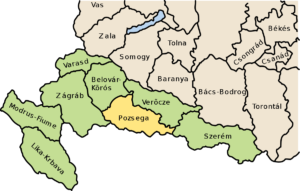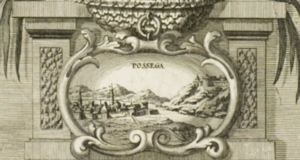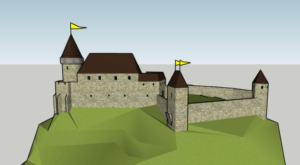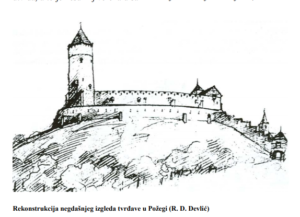Pozsega

The city of Pozsega (Požega, Poschega) is situated in Croatia but it used to be the seat of Pozsega County in the medieval Kingdom of Hungary.
The history of Pozsega before the Ottoman conquest
According to the Gesta Hungarorum of Anonymus (written before 1196), some of the chiefs of the Hungarians who had conquered Hungary in the 9th century, namely Bulcsú, Botond, and Lehel rode from Zagreb to Pozsega Castle and occupied it. Anonymus says it happened in Slavonia, in the area between the rivers Danube and Szutla, near to the towns of Zagreb (Zágráb) and Vlco (Vukovar, Valkóvár). It was the Hungarian King Saint László, the one who had conquered Croatia who handed over the Duchy of Pozega to his nephew, Prince David. Also, he allowed him in 1093 to make the castle of Pozsega available to the abbey of Tihany. In the 13th century, Pozsega was already the seat of the Comes of the County, later the seat of the Slavonic princes.

The first written mention of Pozsega County dates back to 1210 when the Hungarian king donated the estate of Lješnica to the knights of Templars. The name of the castle of Pozsega was mentioned as “Castrum de Posega” in a charter of 1227, in which Pope Honorius III allowed Archbishop Ugrin of Kalocsa to buy the estate of Pozsega so that he could count on it as a base against the Bosnian Bogumil heretics.

The fortress of Pozsega is located on a hill in the present-day city center and was probably built during the 11th century. Pozsega was a royal estate from the middle of the 13th century to the beginning of the 15th century, just like 60% of the Kingdom of Hungary. (Please, note that I am going to use the Oriental name order for Hungarian names where family names come first.)
It was also a free royal city. In 1242, the stronghold successfully resisted the Mongolian armies. Then, King Béla IV donated it to Queen Mary. It was also a favorite place for Queen Elizabeth, the wife of Stephen V, who dated several diplomas from here. The place became the residential estate of the Hungarian queens and was exempt from the authority of the viceroy and the county. In 1385, a parliament was convened in Pozsega to try to persuade the young Queen Mary to still maintain the engagement with Sigismund of Luxembourg.

In 1386, the army of those noblemen who were supporting the usurper from Naples was defeated in a battle at the castle of Pozsega, and in 1387 the castle was recaptured from the Horváti family by King Sigismund’s followers. By the late 14th century, the city started to decline economically due to insecurity from Ottoman raids. Before 1432 it belonged to Tamási László, in 1438 to the queen, and King Albert gave it to the Tamási family again in 1443. After 1444, it belonged to Hédervári Lőrinc and his descendants. In the 15th century, city walls were built, replacing a moat that existed before.

The age of Ottoman conquest
The towns’ fortifications proved an insufficient defense as the Turks ravaged the town in 1532 when they were retreating from the siege of Kőszeg but then, the castle was still successfully defended by King Habsburg Ferdinand’s followers. However, the Ottomans seized Pozsega in 1537, led by the Bosnian Bey Mehmed whose army was reinforced by the Sultan’s troops as well. You can read more about the siege of Kőszeg here:
https://www.hungarianottomanwars.com/1490-1541/a-scene-from-the-last-days-of-koszeg-s-siege-in-1532/
Then, the Turks launched their attacks from Pozsega to occupy the rest of Western Slavonia. During the 150-year-long Ottoman rule, Pozsega was the seat of the Sanjak of Pozsega and was given certain prominence. After a considerable economic decline, in 1537, at the time of the Ottoman conquest, Pozsega reportedly had 110 houses and 15 businesses. However, by 1579, there were 160 craftsmen in the city as a result of improved security and an increase in population.

Lord Zrínyi’s campaign against the Bey of Pozsega
Zrínyi Miklós aka Nikola Šubić Zrinski, the hero of Szigetvár, launched a preventive campaign along the River Dráva in March 1562, in order to crash the fort that was being constructed by the Turkish Bey of Pozsega castle. The warriors of the south-Trans-Danubian Borderland castles joined Zrínyi’s soldiers of Szigetvár castle in the military action. Zrínyi had suggested to Palatine Nádasdy Tamás in February to attack the castle of Koppány but soon he was informed that Bey Arszlán of Pozsega castle had begun the construction of a fort near to the villages of Szentgyörgy and Monoszló. This news modified the destination of the campaign so instead of Koppány they set out towards the forts of the Turkish bey of Slovenia along the river Dráva.
Szigetvár castle had its connections in Slovenia beyond the Dráva river and these lands were endangered by the strategic Ottoman chain of castles so they had to be destroyed by all means. Zrínyi ordered the captains of Babócsa castle, Tahy Ferenc, and Perneszy Farkas to join the soldiers of Szigetvár with their artillery units at Vaska-Szentmárton and he called the other troops from Szenyér there, too. (Zrínyi had liked and known them well from his wars around Kanizsa castle from the 1540s.) Finally, 1,000 Hussars and 2,000 infantrymen had assembled and there were 500 soldiers from Szerény. These numbers seem to be a bit exaggerated, particularly regarding the small fort of Szerény. This palisade castle couldn’t have given so many soldiers except with the combined help of other small castles of Somogy County.

The small army crossed the Dráva River at Szentmárton. The army was divided into three parts. Its middle was led by Tahy Ferenc, riding the borrowed horse of Zrínyi. (We happen to know the name of the horse, its name was Cifra.) The right wing was led by Zrínyi while the left was commanded by Perneszy Farkas. The Hungarian warriors were successful: they attacked and destroyed the forts which were still being built. Bey Arszlán of Pozsega was defeated on the battlefield. The Hungarians gained two flags, two long cannons, 16 hook guns, and two mortars. They also took the tent of Bey Arszlán where they found valuable things and hunting dogs that were kept by Zrínyi himself.

Upon returning to Szigetvár, Zrínyi received the instruction of the Palatine who ordered him to send immediate reinforcement to the castle of Hegyesd that was located at the Highlands of the northern shore of Lake Balaton. Unfortunately, Zrínyi failed to obey this order because he was expecting an Ottoman counter-attack in revenge for his successful destruction of the Turkish palisade forts. His spies reported to him that Bey Kászon was massing together large forces around the city of Pécs and had sent a contingent to Koppány castle as well.
The defeat of the Bey of Pozsega in 1580

On 28-29 September 1580, Nádasdy Ferenc, Zrínyi György (Juraj Zrinski), Batthyány Boldizsár, and Veit von Hallegg, the chief captain of the Slavonic Borderland, defeated the Bey of Pozsega.
The Croatian, Hungarian, and German troops from the Borderland (about 2500 men) went on a raid to the field of Pozsega, but in the meantime, the army of Bey Szkander of Pozsega, which was devastating the Varasd (Varazdin) region, was thoroughly defeated. The Bey was among the 250 Turks who were slaughtered, 430 were captured and 20 flags fell into the hands of the Christians.

It was recorded that in the battle, Zrínyi’s soldier, Budor János, killed a Turk with his spear and sent several others to the other world with his sword. The news of the battle had already reached Emperor Rudolf’s entourage in Prague by the end of October, and the Venetian ambassador wrote a detailed report on it to the leaders of the Venetian Republic.
The decline of the Crescent Moon
The death of Hasan Predojevic, the Pozsega Sanjak Bey in the Battle of Sisak in 1593, marked one of the first major Ottoman defeats in Europe, and after years of steady decline, Ottoman rule grew weaker until Pozsega was finally liberated on 12 March 1688 by citizens led by friar Luka Ibrišimović. This day is now celebrated as the day of the city, however, Pozsega fell to the Turks after a short time, in 1690. On September 29, 1691, it was finally liberated after the victory of the Christian armies at Szalánkemén, when the castle was surrendered without a fight.
Unfortunately, the medieval fortress doesn’t exist anymore. Only fragments of walls remain to remind us that there once stood a fortress. The remaining monuments from that age are the Church of St. Lawrence (first mentioned in 1303), and the Church of the Holy Spirit which was built in 1235.
(Source: partly from Szerecz Miklós, and Szibler Gábor)

Dear Readers, I can only make this content available through small donations or by selling my books or T-shirts:
Please, feel free to support me with a coffee here:
You can check out my books on Amazon or Draft2Digital, they are available in hardcover, paperback, or ebook:
https://www.amazon.com/dp/198020490X or at https://books2read.com/b/boYd81

My work can also be followed and supported on Patreon: Become a Patron!http://Become a Patron!
[wpedon id=”9140″]

https://hungarianottomanwars.myspreadshop.com/all



